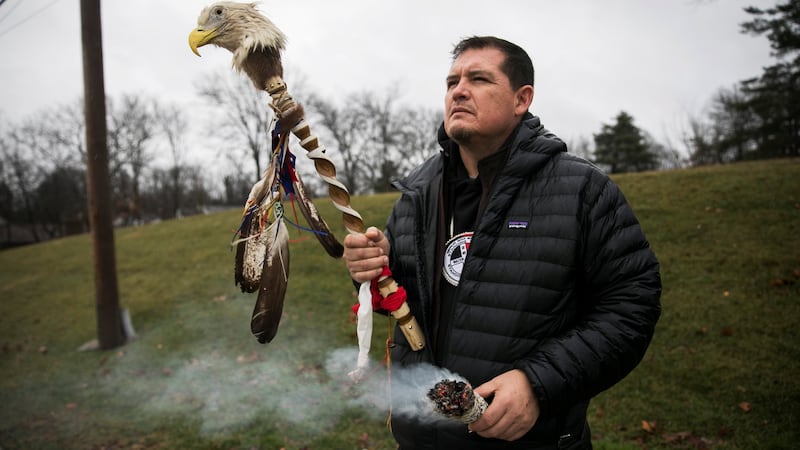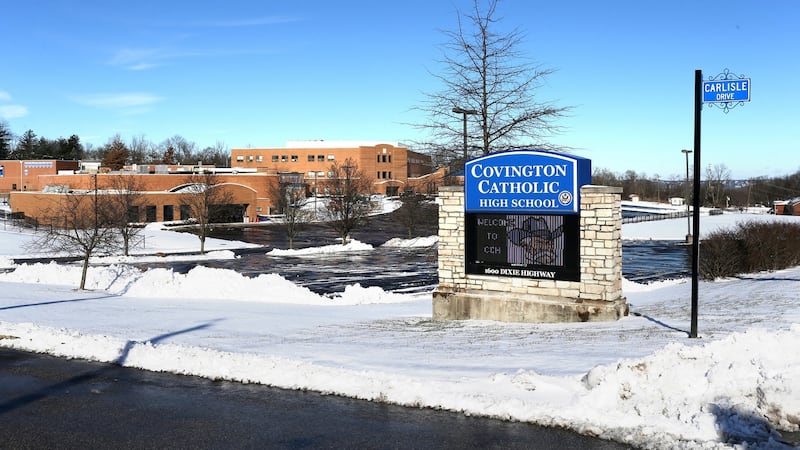It began like any typical January day in Washington. Beneath the bright blue skies, tourists and visitors braved the icy cold temperatures to walk along the grand National Mall, despite being shut out from many of the museums due to the government shutdown.
The long stretch of land that runs through the US capital has long been the site of civil protest, from Martin Luther King's "I Have a Dream" speech to protests about the Vietnam War.
Last Friday, the annual March for Life was scheduled to take place. The pro-life demonstration is held each year in Washington to mark the anniversary of Roe v Wade, the 1973 Supreme Court decision which legalised abortion. The event has gained a higher profile in the last two years following Donald Trump's election. This year the US president delivered a video message to the demonstrators, promising to veto legislation that "weakens the protection of human life". Vice-president Mike Pence and his wife Karen walked with the protesters and addressed the crowd.
The rally took place on the eve of the Women's March, a movement spawned by the election of Donald Trump. Though smaller this year due to internal divisions within the movement and allegations of anti-Semitism, thousands of women still demonstrated across the country, many supported by abortion-rights groups.
But it was not the potential clash between these two groups that caused disturbance. The tension spilled over elsewhere.
As the march finished and the crowds began to peter away, an incident unfolded on the west side of the National Mall on the steps of the iconic Lincoln memorial.
By Saturday, a video clip surfaced online showing a group of male high-school students from Covington Catholic High School in Kentucky wearing red "Make America Great Again" hats in a stand-off with a group of Native Americans. The students had attended the March for Life rally, while the Native American group were in town for the Indigenous People's March. In particular, one student was captured in an intense face-to-face stare-off with a Native American elder who was beating a drum and singing. As the tense standoff continued, groups of students – some appearing to chant "Build the Wall" – surrounded the two as they cheered and taunted.
The real story was what evolved subsequently, and how the established version of the incident changed
The clip lit up the internet, prompting outrage and accusations of racism on the part of the Maga-hat wearing boys, encapsulated by the apparently smug grin of the student involved in the standoff who did not speak to the elderly man in front of him but just stood there, smiling. He was later named as Nick Sandmann.
Mob mentality
For the millions of people who retweeted the incident, the incident exemplified the deep racial and cultural divisions that underpin American life during the Trump era, and an alarming example of mob mentality at work. That outrage was underscored by a CNN interview with the Native American elder, Nathan Phillips, on Saturday, during which he described trying to bring calm to the situation, and describing the fear he felt as he was surrounded by the group and blocked by one particular student.

As reaction to the story grew, Covington Catholic High School and the Diocese of Covington issued a joint statement on Saturday night apologising to Phillips. "We condemn the actions of the Covington Catholic High School students towards Nathan Phillips specifically, and Native Americans in general," the statement said. "... We extend our deepest apologies to Mr Phillips. This behaviour is opposed to the Church's teachings on the dignity and respect of the human person."
It also said it would investigate the incident and take “appropriate action, up to and including expulsion”.
But the real story was what evolved subsequently, and how the established version of the incident changed. It gradually emerged that the prevailing narrative surrounding the events was not all it seemed. A second video surfaced showing a group from the Black Israelites, a fringe group that believe Africans are God's chosen people.
Shouting anti-homosexual slurs and swearing, the group in this video approached the Covington students, at one point appearing to tell a student that his classmate was going to harvest his organs.
The Covington students then began performing their “school spirit” chant, a school chant often used by High Schools in America, led by one student who took off his shirt and began performing the song.
Apparent face-off
At this point, video footage shows the group of Native Americans entering the scene and approaching the student group when the apparent face-off between Nathan Phillips and Nick Sandmann took place.
As debate erupted about why the Native American group approached the boys, conflicting reports began to emerge about Phillips’s Vietnam War record.
As a more detailed and complicated picture emerged about what unfolded on the Lincoln memorial, several well-known figures began to retract their original comments on the incident. By Sunday a full-blown collective mea culpa was in swing across the internet.

Julie Irwin Zimmerman of The Atlantic admitted that "like many people who spend too much time on Twitter", she was outraged when she watched the video that chugged-up her timeline on Saturday. But by Sunday she had begun to reassess her initial response.
“As I watched the longer videos, I began to see the smirking kid in a different light.”
Describing how we are all now “primed for outrage”, she described the story as a “Rorschach test – tell me how you first reacted, and I can probably tell where you live, who you voted for in 2016, and your general take on a list of other issues – but it shouldn’t be.”
The scene that unfolded last week – a group of white male teenagers aligned with President Trump and a Native American man protesting centuries of injustice – seemed to conform to an easy narrative, a modern-day morality tale that tells us all we need to know about the problems of America.
That it took place on Martin Luther King weekend on the very steps where Dr King delivered his "I Have A Dream" speech only underscored the symbolism of the moment.
But the picture was in fact more nuanced.
Nonetheless, many believe the counter-narrative that has prompted many mea culpas and dominated the national conversation over the past week has gone too far. Nathan Phillips still maintains that he felt threatened by the situation and that he was being actively blocked by Sandmann, even though he forgives him. Meanwhile, photographs have surfaced of former Covington school students in blackface at basketball games.
The controversy has also exposed the limitations and dangers of social media – how a single video clip, without context, can become a dangerous tool
Donald Trump has weighed in. On Twitter he said that Nick Sandmann and the students of Covington “have become symbols of Fake News and how evil it can be”.
Press secretary Sarah Huckabee Sanders has invited them to the White House. "Certainly no one understands better than this president when the media jumps to conclusions and attacks you for something you may or may not have done," she told Fox News.
Unsurprisingly, Trump’s supporters in the right-wing press have seized on the incident to lambast mainstream media channels. They have highlighted the fact that CNN, for example, initially reported that the Black Israelite group were “preaching about the bible and oppression”.
The timing of the incident was helpful for those using the Covington controversy as a way of delegitimising the media, given that it unfolded on the same day that special counsel Robert Mueller disputed a story in BuzzFeed claiming that President Trump had instructed his former lawyer to lie to Congress.
The controversy has also exposed the limitations and dangers of social media – how a single video clip, without context, can become a dangerous tool. Rather than the promise of unmediated first-person reportage, the power of the smart phone has generated complex questions of perception and reality, fuelled by a groupthink that can cause people to rush to judgment.
As the national conversation about the incident continued this week, with both Sandmann and Phillips giving sit-down interviews with cable networks, in Kentucky, the small town of Covington appeared to close ranks.
The school was forced to close on Tuesday, citing security concerns. Some of the students, including Nick Sandmann, have reportedly received death threats. Many locals have criticised the diocese for its statement on Saturday and have rallied around the students.
Soul-searching
Nationally, the incident has prompted some soul-searching by commentators and analysts.
New York Times columnist Frank Bruni wrote that many of those who seized on the incident on Twitter on Saturday were simply "burnishing their brands … each pundit one-upping the disdain of the pundits who vented before him or her".
“We react to news by trying to fit it into the argument that we routinely make … We have our narrative, and we’re on the lookout for comments and developments that back it up.”
As he succinctly put it, in the current climate, “instead of bucking the political tribalism in America, we ride it”.
As the dust settles on the controversy, it remains unclear what lessons America will take from the controversy. Given the polarized nature of debate on mainstream and social media, it is most likely that people will just continue to see what they want to see.













